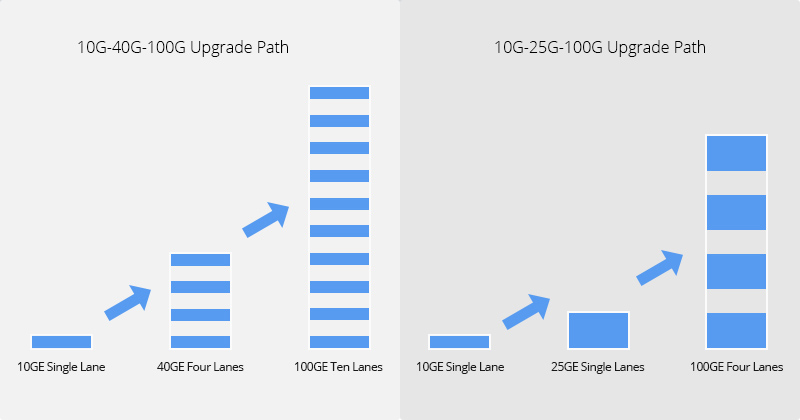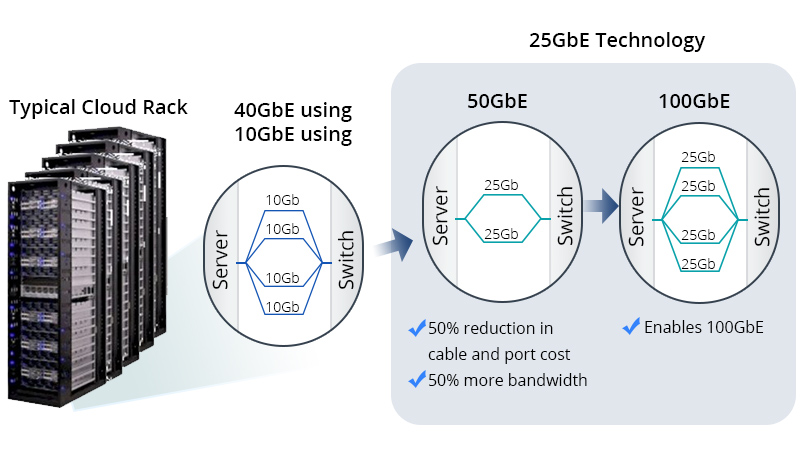10G SFP+ to 25G SFP28 or 10G SFP+ to 40G QSFP, Which Upgrade Path is Better?
25G Ethernet vs 40G Ethernet Overview
25G Ethernet standard is an incremental update from 10G Ethernet, and has the smallest pluggable form factor referred to as SFP28, which is similar to SFP+. The 25G SFP28 modules are backward compatible with SFP+ ports and existing data center infrastructure while seamlessly upgrading to 100G and beyond. SFP28 has a single lane at 25G, which supports efficient upgrading to 100G server connections at 4x25G configuration. The 25G Ethernet is generally applied in data center interconnects for storage, serves, switches, and 5G fronthaul.
40G Ethernet was the only upgrade transition path to higher speed 100G connectivity before the 25G Ethernet standard was issued. QSFP+ is the mainstream form factor type for 40G Ethernet transceiver, which provides four transmit and four receive lanes to support 40 Gigabit Ethernet applications. 40G Ethernet is mainly generally applied in the connection between data center switches to help break the bottleneck of the connection between access switches and distribution switches.
10GbE SFP+ to 100GbE QSFP28 Network: Should You Upgrade via 40GbE QSFP or 25GbE SFP28?

Fig. 1 - 10G-40G-100G vs 10G-25G-100G upgrade path
From 10G SFP+ to 40G QSFP+ to 100G QSFP28 Upgrade Path
The 10G-40G-100G upgrade method relies on combining multiple 10G channels, such as 40G is composed of 4x10G parallel lanes, and 100G is composed of 10x10G parallel lanes. This method can be expanded on the basis of the existing 10G, which is relatively space-saving and cost-effective when wiring.
But the problem is that 40G is essentially just a bundle of four lanes at 10G speed, and it does not bring significant improvements in power optimization, rack space utilization, or compatibility with rate evolution. Therefore, in the long run, this upgrade solution does not have many advantages.
From 10G SFP+ to 25G SFP28 to 100G QSFP28 Upgrade Path
The 10G-25G-100G upgrade path provides 2.5x higher bandwidth connectivity of the 10G in 25G Ethernet with only slightly increased cost. The upgrade path achieves 100G Ethernet by 4x25G based on 25G switch infrastructure without having to re-plan or change server per rack density, which saves a large number of fiber resources also. Moreover, the power consumption of the 4x25Gbit/s configuration is much lower than the 10x10Gbit/s configuration.
Why Choose 10G SFP+ to 25G SFP28 Rather than 10G SFP+ to 40G QSFP?
SFP28 25G is Back Compatible with SFP+10G Optical Modules
25G SFP28 transceiver has a similar form factor to the existing 10G SFP+ transceiver, it is backward compatible with SFP+ 10G. Also, the 25G switch has higher compatibility than the 40G switch. The majority of 25G switches and NICs (Network Interface Cards) enable backward compatibility to 10G and provide higher flexibility to manage a gradual upgrade to higher data rate servers and match port speeds.
Higher Bandwidth of 10G SFP+ with Dense 25G SFP28 Port Density
25G SFP28 optical modules enable network equipment manufacturers to provide 2.5 times higher bandwidth than 10G while consuming similar power to 10G, and its power consumption is much lower than 40G modules. In addition, the port density of 25G SFP28 modules is higher than that of 40G QSFP modules, which means that more 25G ports can be deployed in the same equipment space, thereby improving overall network performance and efficiency.
If you don't know how to pick the right SFP28 25G optical module, you can read this article: How to Choose an SFP28 Transceiver: SFP28 Wiki, Types and Application
25G SFP28 is Better Matched to 50G/100G Upgrading
25G Ethernet uses single-channel 25G SerDes technology, while 40G Ethernet is composed of four 10G channels. Therefore, when using 25G SFP28 optical modules, 50G Ethernet can be combined through two 25G channels, or 100G Ethernet can be combined through four 25G channels. In this way, higher bandwidth upgrades can be achieved without re-adjusting the layout of the server rack or performing additional network planning, as shown in Fig.2.

Fig. 2 - 25G SFP28 is better matched to 50G and 100G upgrading
25G-100G Upgrade Path is More Cost-effective than 40G-100G Path
Upgrading from 25G to 100G can be achieved by 4x25G, the CapEx(Capital Expenditures) and OpEx (Operational Expenditures) saved by utilizing the existing cabling infrastructure and high backward compatibility. In general, this upgrade solution makes the use of switch ports more efficient while reducing the cost of overall bandwidth expansion.
Conclusion
As cutting-edge technologies emerges and business needs grow, your 10G network infrastructure faces the challenge of upgrading to higher data rates. 10G SFP+ to 25G SFP28 and 10G SFP+ to 40G QSFP+ are two solutions to transit the transformation to 100G Ethernet. While considering backward compatibility, power consumption, port density, adaptability to legacy 2x 25G and 4x 25 configuration, and cost-efficiency, 25G SFP28 provides a future-proofing method to upgrade to 100G access. With the trends of enterprise server access gradually changing from 1G-10G to 10-25G, the number of 25G SFP28 port shipments will continue to grow in the next few years.
QSFPTEK provides widely compatible and quality assured 25G SFP28 transceivers at the best price based on mature 25G SFP28 production techniques. You can ask any questions about SFP28 via [email protected].










